How Was The Painting In The Voyage Of The Dawn Treader
For The Chronicles of Narnia: The Voyage of the Dawn Treader, visual effects supervisor Angus Bickerton led the creation of some 1400 shots in the third motion-picture show adaptation of C.S. Lewis' fantasy serial. We highlight a number of the central effects by Framestore, MPC, Cinesite, The Senate and The Mill.
Framestore
Picture perfect Narnia
The Pevensie children, Lucy and Edmund, and their cousin Eustace, enter Narnia this time effectually via a magical moving painting of rolling waves and the Dawn Treader ship, brought to life by Framestore. Information technology was too decided that the shot of the flat painting turning into the Narnian scene would exist more effective in stereo. Framestore worked with Prime Focus to realise the shot, delivering various elements for re-compositing or creating the shots entirely in stereo.
"To commencement with," said Framestore visual effects supervisor Jonathan Fawkner, "we plant some moving footage of waves and and then, using an over-painting technique in Corel Painter, managed to make a single frame wait pretty close to the source painting but based on moving images. So we used the motility from the footage to drive the painting using an optical flow analysis. It would drive information technology for about 20 frames before it started breaking. You'd accept to go back to the original source material and make a new painting using the over-painting technique and optical flow frontwards and backwards between them."
The camera tracks frontwards towards the painting just, instead of stopping, it hits the airplane of the painting and goes into 3-D depth and the camera continues to fly across the h2o. "That meant animative the off-set of 2 eyes so that we had an animated dimensionality," said Fawkner. "Nosotros transitioned into some work done by MPC for the Dawn Treader at ocean, using their CG water to bulldoze the painting as nosotros collection the camera that allowed us to go from beingness a flat painting to a three-dimensional world."
Aslan roars again
Having realised Aslan in Prince Caspian, the second Narnia pic, Framestore resurrected the noble lion for 60 shots in Dawn Treader. These included extreme close-up shots for a conversation Aslan has with Lucy and for a final scene in front of a giant non-breaking moving ridge. "On the last show nosotros had been asked to get for a aureate fantasy lion but this fourth dimension we went with more of a real lion," recalled Fawkner. "So we changed his colour palette to be a more than realistic lion color. And we introduced a darker mane."
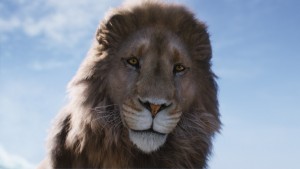
Framestore completely ported the previous fur organisation to an updated 2010 version written past the studio's in-firm software tools group. "In the previous picture it had been a massive compositing job," said Fawkner. "For Treader information technology was more of a naturalistic procedure for the lighting TDs. If they put a calorie-free in there, it behaved in a way that was predictable. When you've got things similar semi-translucent hair, it absorbs light at unlike depths, in the deep shadow of his mane and nevertheless also transmits light if it's behind him. These things are complicated and then we had to completely re-write the shader set." Aslan was likewise re-rigged using the studio's key muscle system to better accommodate certain points of view of the lion, such as him walking in contour.
To create the fur, artists used a node-based approach, splitting Aslan into four separate grooms for the face, torso, mane and tail. They so assembled a network of 'hair filters', including hair calibration, scraggle, interpolation, clumping, alopecia, width and color. "Each filter has many parameters and each parameter allowed the connexion of a texture map for total control," explained Fawkner. "This was painted in existent time in the Maya view port and would give immediate feedback to inform the groom."
Aslan ended up with about half-dozen million hairs, with the overall shape and book of Aslan's mane came from guide hairs constructed using Maya curve geometry. "Thousands of secondary guide hairs were then procedurally generated through the hair filters network," said Fawkner, "and the whole mane driven by the dynamic simulation of just a few hairs."
One-legged Dufflepuds
For the one-legged dwarf-like Dufflepuds who meet Lucy and the remainder of the Dawn Treader coiffure, Framestore was challenged to augment scores of live-action performances with CG. "These creatures are very agile and jumpy so to go the best result we would have actually had to take gone fully 3D," said Fawkner. "But 16 fully 3D characters each with a different haircut and apparel was just a huge amount of work. So it was decided to get with a CG leg and trouser approach."
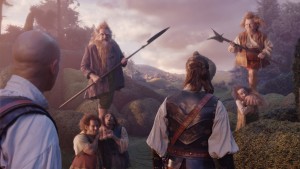
Production shot clean plates of the Treader crew reacting to the non-existent Dufflepuds. "Basically it was me and Angus Bickerton running around first similar loons on the prepare," remarked Fawkner. "Then they shot it once again without u.s. and they'd all try and remember what they were looking at." A divide bluescreen shoot of the jumping Dufflepud actors or stunt performers on trampolines or springboards likewise aimed to match the previous plates.
"The process involved roughly placing the actors into the shot and selecting them in the Avid," said Fawkner. "Then we body-tracked each one. Later that nosotros stuck a single CG leg onto a body-tracked operation and gave that to the animator to animate the leg underneath. We were able to introduce some z-depth by moving an actor further away simply we couldn't twist him effectually and testify the forepart of him if what was simply photographed was the back."
In the one-infinitesimal sequence, Framestore had to conform 250 individual performances, re-timing elements on occasion if the Dufflepuds needed to jump college than had been shot. Some of the creatures were realised entirely as CG assets to enhance performances and make full out the scenes, since on set only 10 costumes had been available. "Information technology wasn't actually until we got to the end of that process that Angus could say: 'Yeah, it's working'," recalled Fawkner. "Simply adjusting the amount of motion blur, for instance, fabricated such a difference to how the animation felt."
Background environments and the revealing of invisible elements also fabricated upwardly a pregnant part of the Dufflepuds sequence, when Lucy enters the mansion of magician Coriakin through an invisible door. "Lucy walks through the door and the photographic camera goes around the outside and looks at the garden beyond," said Fawkner. "That was all completely re-built from the set photography and from a LIDAR browse because basically it was her looking effectually a big bluish box. I recall the stereo really sold that shot, too, of having the door open up in the middle of nowhere."
After, the invisible mansion is revealed to the Treader crew. "We had two buildings," explained Fawkner, "one essentially textured with the views of the sky and the hills in the background, and i textured like a building. Nosotros got ii point clouds and nosotros off-set them in space from each other and literally just rotated those two betoken clouds around so that it went from one view to some other, only with a sort of three dimensional look to information technology, rather than information technology just beingness a straight dissolve. We also blithe some ivy over the pinnacle of it, just to make it a niggling scrap more interesting." A similar reveal gag for the invisible Dufflepuds relied on 2nd filters to glassify the creatures and then bring them into view via compositing.
The wave that never crashes
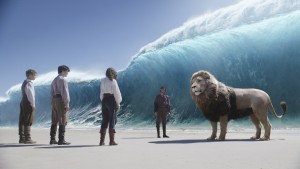 In 1 of the concluding scenes in the moving picture, the characters run across Aslan in front of an ominous non-breaking wave, before leaving Narnia through a magical pigsty in the water. The scene was shot at Jumpinpin most Brisbane on a large flat spit of land, with Framestore inserting the moving ridge every bit a computer generated fluid simulation.
In 1 of the concluding scenes in the moving picture, the characters run across Aslan in front of an ominous non-breaking wave, before leaving Narnia through a magical pigsty in the water. The scene was shot at Jumpinpin most Brisbane on a large flat spit of land, with Framestore inserting the moving ridge every bit a computer generated fluid simulation.
Markers placed on the beach set out the proposed location of what was conceived as an enormous standing tidal wave. "Our problem was that it was to be on screen for minutes and minutes," said Fawkner. "And in broad daylight. The other trouble was how to realise the wave given that it was kind of alive but too static. We as well had to piece of work out just where all the water was really coming from."
To alleviate these concerns, Framestore came upwardly with a system to describe a moving ridge's natural movements, as Fawkner explained: "It was something like A: flat water without breaking, B: starting to become white water on the crest, C: bigger white h2o, D: information technology has tipped over, East: a complete tube. Nosotros thought we could easily oscillate betwixt A and C without it ever going completely over because nosotros couldn't conceive of it ever getting dorsum from a country where information technology has crashed."
For the corpus of the wave, artists displaced the surface to brand a wave shape and and so increased the rotation effectually an off-set centre to get a more avant-garde or less avant-garde wave. "On top of that we had four levels of Tessendorf displacement which had to be tuned to give information technology the right sense of scale," said Fawkner. "Then nosotros developed some nice shaders that immune the wave to refract and diffuse light in a naturalistic way."
"We went from a deep oceanic colour most the bottom to doing a glorious azure kind of bounding main," continued Fawkner. "On top of that nosotros stuck a particle arrangement which was driven by the fact that we knew where the crest of the moving ridge was. We modulated the particles based on our stage map – A, B or C – and too by undulating Tessendorfs which went into a fluid solve for how the spray would be blown off the top of the wave."
"Nosotros also still had this problem of where does this water come from? It was just kind of shooting up from the ground. Fortunately, for about of the shots the photographic camera was quite low to the ground, so we could composite in some elements of crashing waves or some running in reverse. That seemed to generate the right level of racket at the bottom to suggest that it might accept been coming from somewhere."
Within the standing moving ridge, Framestore utilised Maya particles to form a sandy cloud look, also relying on its proprietary deep shadow Occvox (apoplexy voxels) software, and raytracing in RenderMan. The magical pigsty through which the characters leave Narnia was accomplished using Exotic Matter's Naiad software in conjunction with Framestore'south front end-end called Fluidity.
The Moving Movie Company
Setting sheet with the Dawn Treader
A number of methods were used to realise the film's titular ship at ocean, each more often than not requiring digital augmentation by MPC under visual effects supervisor Adam Valdez. In Queensland, Australia, production built a full-scale replica of the Dawn Treader on a steel turntable and motion rig situated on a peninsular of land overlooking the ocean. This gave an almost 150 degree view to the horizon that could exist changed depending on the angle of the sun. The gear up was and so re-erected inside a bluescreen stage for shots of the ship at night, in a storm and during the Dark Island sequence.
Terminal shots were a mix between the applied photography, existent ocean plates and digital water simulations, along with the addition of a digital crew, mast, prow, sail, rigging and other fixes. "They found a steel-hulled boat that they sailed effectually the waters of Australia and New Zealand and did a bunch of helicopter plates," said Valdez. "We would track the camera and the boat and completely supplant it with a full CG boat, including the coiffure. Nosotros too did a fair number of shots to extend the base of operations of the transport where it meets the waterline. Any time we see the side of the boat coming together the water, it was never really in the h2o, then that was either a combination of body of water plates beingness married up or a petty bit of CG water or a CG gunkhole hull."
Reepicheep rides again
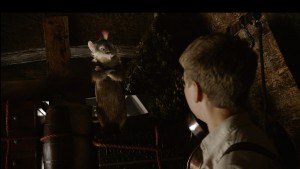 MPC revisited its graphic symbol animation work from Prince Caspian for Reepicheep, the valiant talking mouse, making him slightly older. "That ended upwards being a very subtle set of changes," recalled Valdez. "We saturated his colour a little, gave him slightly bushier eyebrows and some extra ear hair and fabricated his whiskers a little more wirery only to give him a sense of age. He's also a trivial more pot-bellied than he was in the last film." Artists also gently brought Reepicheep's eyes forrad to make close-upwardly angles on the character more distinguishable, with the fur groom ported over and the rest of the facial model slightly re-built to better control oral cavity and eye shapes.
MPC revisited its graphic symbol animation work from Prince Caspian for Reepicheep, the valiant talking mouse, making him slightly older. "That ended upwards being a very subtle set of changes," recalled Valdez. "We saturated his colour a little, gave him slightly bushier eyebrows and some extra ear hair and fabricated his whiskers a little more wirery only to give him a sense of age. He's also a trivial more pot-bellied than he was in the last film." Artists also gently brought Reepicheep's eyes forrad to make close-upwardly angles on the character more distinguishable, with the fur groom ported over and the rest of the facial model slightly re-built to better control oral cavity and eye shapes.
For a sword fighting lesson that Reepicheep gives to Eustace, MPC based its own animation on previs work past Mike Makara. A stuffie on set fabricated of large rodent pelts, along with eyeline markers, helped actor Will Poulter engage the non-existent mouse, besides as providing reference for MPC's digital artists. "We and so sent our animators off to fencing school where they learned what sort of presence y'all have with a foil and how yous residual and use information technology," said Valdez. "This was likewise essentially a teaching scene, giving Eustace the nuts of swordplay, and I retrieve that shows the in the quality and flow and elegance of the shots."
Digital water simulations were carried out in MPC'southward version of Flowline that runs inside Maya, and so rendered in RenderMan. "We would simulate surfaces," explained Valdez, "and so practice localised simulations for any time the surface is disrupted, such as for boat wakes or whatsoever time a animal splashes the h2o or water collides with objects."
"The storm sequence was difficult considering it required a huge particle arrangement," continued Valdez. "We started with an animated surface and the layout department figured out how large the waves should be, what the cameras were going to and then blithe the boat. That was handed off to FX who then divided the shots upward by their technical problems. And then you lot would have wide shots with giant rolling waves, so say shots with water rushing off the gunkhole."
MPC blithe the h2o to be layered with different particular to give wavelets along the surface. Then, a final standoff simulation was produced with the Dawn Treader actually traveling along the surface. "Information technology's kind of a weird round process," recalled Valdez, "considering you'll do the wave, so the animator will do the boat and the animator is figuring out how the gunkhole is reacting to the wave, making it go wearisome, or rocking to the side and carving through the wave. Then yous give that to the sim guy and he runs the sim, just what's he really doing is running a sim for the intersection of the boat and the wave surface. Those 2 things accept already been computed so he'due south generating the crashing water equally a issue of these 2 pre-animated elements. If that looks insane, like the boat is moving as well fast or the waves are too big, we have to make decisions most whether to cheat physics or get the boat to slow down a footling bit. You desire the best of simulation but y'all might want to crook physics as well."
Eustace the dragon
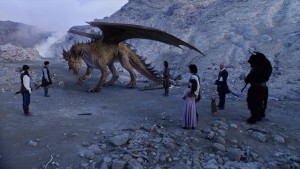 At one point on their Narnian adventure, Eustace discovers a stash of golden treasure and begins pocketing his new establish riches. But the result is that he is cursed into a flying and fire-breathing dragon, a digital creature generated by MPC. Basing their pattern on a maquette by special furnishings and make-upward supervisor Howard Berger, MPC artists produced a dragon to suit the film'south classical product blueprint. "I call up what is expected these days is that yous have to believe in the dragon, so you couldn't do anything krinkly or ornate. We also came upward with the thought of connecting him visually with the curse of the treasure he had stolen, so nosotros sewed in this golden result into the shading."
At one point on their Narnian adventure, Eustace discovers a stash of golden treasure and begins pocketing his new establish riches. But the result is that he is cursed into a flying and fire-breathing dragon, a digital creature generated by MPC. Basing their pattern on a maquette by special furnishings and make-upward supervisor Howard Berger, MPC artists produced a dragon to suit the film'south classical product blueprint. "I call up what is expected these days is that yous have to believe in the dragon, so you couldn't do anything krinkly or ornate. We also came upward with the thought of connecting him visually with the curse of the treasure he had stolen, so nosotros sewed in this golden result into the shading."
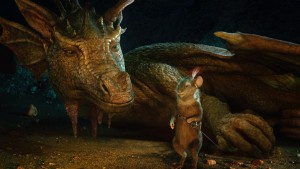 Eustace as the dragon was modelled in Maya with fine particular created in Zbrush. MPC used its proprietary plug-ins for Maya and other tools for muscle and skin simulations. To ensure the flight of the creature was believable, artists added thick skin at the base of the wings and to where information technology met the arm joints. The last look of the skin was based on crocodile reference which had the appearance of scales just retained a leathery feel. "I knew nosotros would have these medium and tight shots, so when the skin plain-featured I didn't want it to be distracting and have that standard, CG stretchy wait," said Valdez. "Nosotros spent some fourth dimension figuring out how to preserve the expanse of the skin and use more than folding – and so that any of the studs around his trunk or the texture wouldn't squash and stretch too much."
Eustace as the dragon was modelled in Maya with fine particular created in Zbrush. MPC used its proprietary plug-ins for Maya and other tools for muscle and skin simulations. To ensure the flight of the creature was believable, artists added thick skin at the base of the wings and to where information technology met the arm joints. The last look of the skin was based on crocodile reference which had the appearance of scales just retained a leathery feel. "I knew nosotros would have these medium and tight shots, so when the skin plain-featured I didn't want it to be distracting and have that standard, CG stretchy wait," said Valdez. "Nosotros spent some fourth dimension figuring out how to preserve the expanse of the skin and use more than folding – and so that any of the studs around his trunk or the texture wouldn't squash and stretch too much."
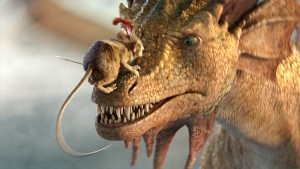 "At that place was likewise a desire for him to have a very monochromatic colour palette," noted Valdez. "He does take variation in his colours, but he is pretty much a kind of ruddy orange with gilded. That turned out to be quite difficult to light and make look natural in different environments. Our digital photography was fairly stark and natural in its await, so you had this very saturated creature with a adequately complex shader and a lot of detail. That really came downward to compositing in the end. The lighters provided us with lots of material and so nosotros figured out how to exaggerate the gilt in certain circumstances when the lighting didn't necessarily justify it."
"At that place was likewise a desire for him to have a very monochromatic colour palette," noted Valdez. "He does take variation in his colours, but he is pretty much a kind of ruddy orange with gilded. That turned out to be quite difficult to light and make look natural in different environments. Our digital photography was fairly stark and natural in its await, so you had this very saturated creature with a adequately complex shader and a lot of detail. That really came downward to compositing in the end. The lighters provided us with lots of material and so nosotros figured out how to exaggerate the gilt in certain circumstances when the lighting didn't necessarily justify it."
Nighttime Island and attack of the body of water serpent
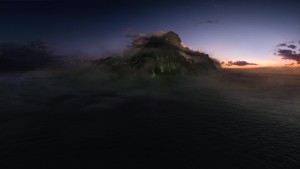 The Dawn Treader crew run across new evils and creatures virtually Dark Island, an environment besides created past MPC. "Our FX department came up with these throbbing, living columns of fume that had these glowing lights in them," explained Valdez. "The compositors and then had the renders, which took days and days to do, and put them on two-and-a-half-D cards. Information technology was a nice collaboration with matte painters, FX guys doing column renders so compositors using Nuke's 3D environment to bring it together. Nosotros also layered in a combination of volumetric fog renders for the immediate temper and lots of elements. Then there was a lot of heavy grading to foreground bluescreen photography of the Dawn Treader."
The Dawn Treader crew run across new evils and creatures virtually Dark Island, an environment besides created past MPC. "Our FX department came up with these throbbing, living columns of fume that had these glowing lights in them," explained Valdez. "The compositors and then had the renders, which took days and days to do, and put them on two-and-a-half-D cards. Information technology was a nice collaboration with matte painters, FX guys doing column renders so compositors using Nuke's 3D environment to bring it together. Nosotros also layered in a combination of volumetric fog renders for the immediate temper and lots of elements. Then there was a lot of heavy grading to foreground bluescreen photography of the Dawn Treader."
Somewhen the Dawn Treader is attacked by a behemothic body of water snake, a creature that went through a number of design iterations. "The end composition everybody picked was the most far out design that we had," said Valdez. "I think everyone reacted to the concept art that had all these crazy spines." Early animation tests of the re-designed serpent ensured that the animal could move appropriately before information technology was free-class sculpted in ZBrush and completed in Maya.
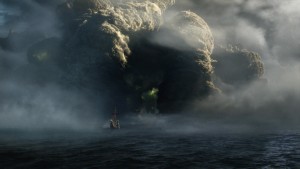
For the attack scenes, animators started with full general layout and blocking while the blueprint of the snake continued. This had to also match with the motility of the Dawn Treader. "Our boat was travelling in Maya through the scene with the correct speed and continuity and directions," noted Valdez. "These days the departments like FX actually really do rely on the correct speeds and continuity to practice their work. We had a large team on the sequence – maybe 150 people – then it really helped that the scene had all in the right continuity and was not just a bunch of shots."
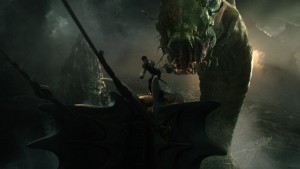
Wreaking havoc on the Dawn Treader, the sea serpent effects extended to harm on the transport, water simulations and the surrounding Night Island environments. "The scene was scheduled effectually the water simulation," said Valdez, "so nosotros had sure beats of the scene beingness done get-go, because the water sim guys needed them done early. We came up with a way of re-using a water cache for the ocean surface at dissimilar storm levels. We did a roller coaster ride for the beats of the scene to friction match the action. Ultimately, the sea was really an extension of the creature and the Night Island above u.s.."
Cinesite
Cities, evil mists and the White Witch
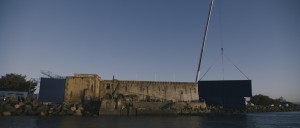
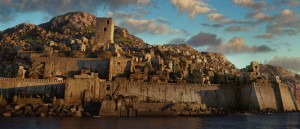
Responsible for a number of city and isle environments, the evil greenish mist and the White Witch was Cinesite, under visual effects supervisor Matt Johnson. The city of Narrowhaven was one of several environments created past the studio. Production shot a location in Australia with a practical harbour wall, to which Cinesite added CG housing and structures gear up on steep rising cliffs. "Everything had to accept a very natural kind of feel and needed to look very empty," said Cinesite visual effects supervisor Matt Johnson, "considering the expert energy had been sucked out past the evil green mist. The banners and awnings are simply subtly flapping in the wind, just to give a petty life to an otherwise drab environs. The CG had to look quite organic and non have too many sharp edges or straight lines."
The light-green mist tendrils – which embodied pure evil and unknowingly took the course of the Dawn Treader crew'south greatest fears – were a recurring upshot in the film. Cinesite relied on fluid simulations in Houdini and about 15 passes to achieve the final wait. "Outset we started by animative an eel shape that was emitting particles," said Cinesite 3D supervisor Stephane Paris. "We were able to play with the speed and movement to make information technology seem more than evil."

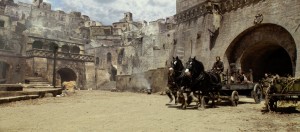
To create the White Witch, Cinesite took greenscreen photography of extra Tilda Swinton and digitally massaged her into a more ethereal beingness. Artists generated a 3D model of Swinton's head and animated it in Maya. "Nosotros kept her face up and shoulders," explained Johnson, "but then gave her face up a more than magical await and created CG hair and rendered mist passes for her body."
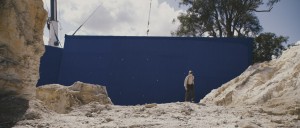
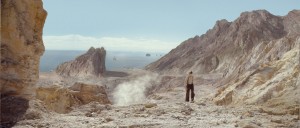
"In the comp what they had to practice was to block out the moves and collaborate with things. That was and so sent to tracking who had to re-track what Tilda was doing to match the 3D sim of the smoke. It was a combination of shooting/comp/tracking and going back to 3D. We wanted to make sure as she flowed, her hair flowed also."
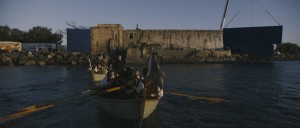
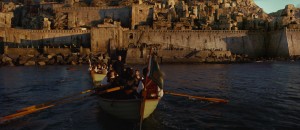
The Senate Visual Effects
Establishing shots, magical maps and a star
The opening shot of Dawn Treader is a crane movement over what initially appears to exist Narnian tower architecture. The sudden flyby of a Spitfire plane and the continued pull-out reveals the location to be wartime Cambridge, created with the help of digital work past The Senate Visual Furnishings. To orchestrate the 45 2d-long scene, The Senate previs'd the move to have a Technocrane feel over the tower and so back to street level as the Kings College gatehouse comes into view. Product emulated the move with alive action extras and street activity in Cambridge in front of a large corporeality of bluescreen.
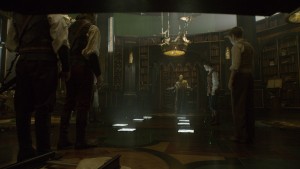
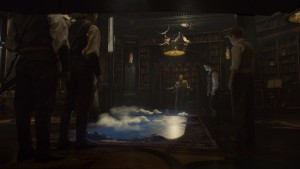
The Senate then matchmoved the live action and added in the requisite tower, plane and other structures. "We modelled the buildings in Maya using thousands of bracketed photos nosotros had taken," explained Senate visual effects supervisor Richard Higham. "It also happened coincidentally that the belfry itself had a lion caput repeated effectually the sides of it. We got in quite close and used Mudbox for the extra item to add together in blemishes and weathering."
The Senate was as well responsible for a number of furnishings within Coriakin's library on Magician'due south Island, including moving 3D letters and flipping pages on a spell book Lucy reads, and additions to the library environment. For a shot of Coriakin actualization out of invisibleness in front of a table of glass jars and books, Higham referenced octopus footage that appeared to show the brute changing its pare color as camouflage. "Angus Bickerton actually liked the organic and concrete nature of that," remarked Higham. "Information technology wasn't merely a lite thing – it seemed to emulate from the physical object the octopus was attached to."
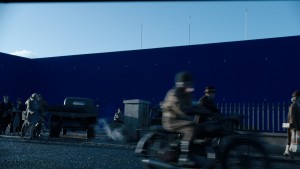
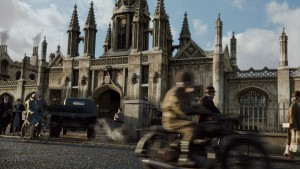
A plate of the player performing the scene and and so a clean plate of the same movement were shot on set. Artists then modelled a bones shape of Coriakin from a cyberscan, projecting it onto the clean plate. "That becomes the texture and if you lot're doing information technology from 1 frame, y'all just play the shot," explained Higham. "At the offset everything will be invisible, but as y'all travel forwards, something will offset to look odd. The perspective shift won't look correct."
"Ultimately, that had a certain flatness to information technology," continued Higham, "so nosotros and then modelled the bits and pieces of what was behind Coriakin and used that to peel into his body using refracting shaders. We besides went for that octopus look – a bit like when y'all drop some ink on a tissue and information technology bleeds through – we wanted that to exist the overall reveal. The bodily 3D render of Coriakin was then used as a matte in compositing to reveal the transition. The trick was nosotros didn't really render something in 3D that we would employ as a master beauty for this shot. You lot're really giving different passes that can be further played with."
Coriakin unravels a magical scroll containing a map of Narnia and the locations of the vii swords of the lost Lords, which must exist establish by the Dawn Treader crew. "Nosotros shot the actor unrolling with a real scroll first," said Higham, "and then got him to exercise it without the scroll, which we subsequently matchmove animated to his hand."
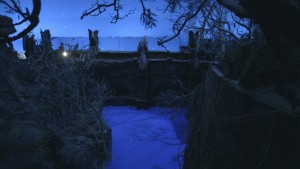
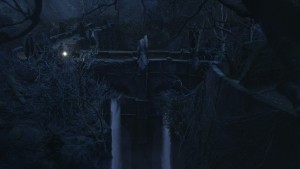
Fully unraveled, the map measured 18 x 9 anxiety and contained 3D models of various islands, waterfalls, the ocean and clouds. Effectually the edge, The Senate animated scenes that were nods to the previous Narnia films, like the rotating tree from Prince Caspian. "The border animations were initially painted backdrops from production and and so isolated clips from the previous films," noted Higham. "We did all this in Subsequently Effects and rendered information technology out. Just one quarter of the map was over 7,500 x three,000 pixels and rendered as an actual file sequence. The shaders would exist referring to 100 or 200 frames of a huge prototype – and that's only the edge!"
The Senate besides contributed shots for the Island of Ramandu visited by the Dawn Treader coiffure, where they also find Aslan's Table. Scenes of the approach to the island were made up of plates shot off the Australian coast and combined with isle reference photography, matte paintings and salt waterfalls. Shots near Aslan's Table were mostly filmed against bluescreen and included complicated environments and atmosphere placed across the live action ready.
The crew encounter Lilliandil, a star actualization from the sky that transforms into the figure of a girl with a continued glow. "They actually shot a calorie-free bulb on motion command and with miniatures in heavy atmosphere," said Higham. "We would animate our star over the summit in 3D and that gave us all the proper interactions of calorie-free." Particle and fluid sims were used for the star, with 2nd techniques to sustain the actresses glow throughout the scene.
The Mill
The Naiad water nymphs
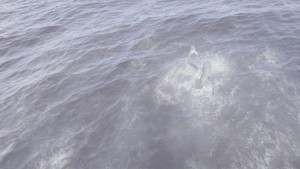 A magical Naiad h2o nymph who greets Lucy on her arrival to Narnia and later warns against travelling to Magician's Isle was created past The Factory. "We were asked to reference a young girl for the Naiads," said The Factory 2d supervisor Sara Bennett. "She was leaping through the h2o and it was difficult to brand for an elegant girl as she'due south doing that. So we decided to get rid of the legs and just take it more than like a fishtail or a dolphin. Angus Bickteron also shot some performance artists pond around the h2o to drive our animation."
A magical Naiad h2o nymph who greets Lucy on her arrival to Narnia and later warns against travelling to Magician's Isle was created past The Factory. "We were asked to reference a young girl for the Naiads," said The Factory 2d supervisor Sara Bennett. "She was leaping through the h2o and it was difficult to brand for an elegant girl as she'due south doing that. So we decided to get rid of the legs and just take it more than like a fishtail or a dolphin. Angus Bickteron also shot some performance artists pond around the h2o to drive our animation."
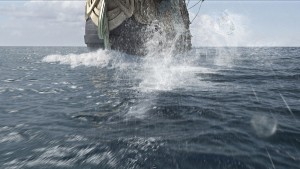 "The concept was that she would e'er be made of water and water was always flowing from her," connected Bennett. "That led to i problem where the early h2o sims started to make her await a little messy, and you couldn't read her features. And then nosotros changed this and then that the body of water was part of her body jumping in and out of the water. She sat above the water with more like drips coming off her. More often than not her face was very solid then we could read her expressions as well."
"The concept was that she would e'er be made of water and water was always flowing from her," connected Bennett. "That led to i problem where the early h2o sims started to make her await a little messy, and you couldn't read her features. And then nosotros changed this and then that the body of water was part of her body jumping in and out of the water. She sat above the water with more like drips coming off her. More often than not her face was very solid then we could read her expressions as well."
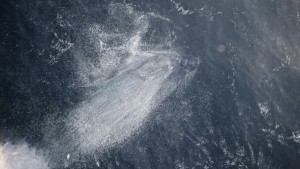 A Naiad model was generated in Maya based on a human form and then modified with a tail. Alloy shapes were used for the Naiad face. Artists took the model into RealFlow to create water simulations, and rendered using Next Limit's renderkit. "We were actually working with Next Limit on new software they were blastoff testing," said Mill effects artist Andy Guest. The actual sea surface was created in RealWave, which is part of RealFlow. In some shots, The Factory blended real body of water plates with their digital Naiad, and added occasional 2nd splash elements to integrate the grapheme in the scene.
A Naiad model was generated in Maya based on a human form and then modified with a tail. Alloy shapes were used for the Naiad face. Artists took the model into RealFlow to create water simulations, and rendered using Next Limit's renderkit. "We were actually working with Next Limit on new software they were blastoff testing," said Mill effects artist Andy Guest. The actual sea surface was created in RealWave, which is part of RealFlow. In some shots, The Factory blended real body of water plates with their digital Naiad, and added occasional 2nd splash elements to integrate the grapheme in the scene.
Source: https://www.fxguide.com/fxfeatured/narnia_the_dawn_treaders_vfx_crew/
Posted by: dyerraident.blogspot.com

0 Response to "How Was The Painting In The Voyage Of The Dawn Treader"
Post a Comment